Algebra Skills: Support at Every Step Transcript
Marjie Dowling: My name is Marjie Dowling
Gary Akin: And I'm Gary Akin
Marjie Dowling: And we are coteachers in a 9th Grade Algebra Skills Class.
Gary Akin: Welcome to our lesson on solving equations.
Gary Akin: This is an Algebra Skills class. 9th Grade. It's a group of students who - their skills were not high enough at the beginning of the year to be in an Algebra 1 class.
Chuck Pack: It became clear to us as a department that our students were not quite ready to engage in Algebra 1. The skills weren't there that they needed to be successful in Algebra. So, Gary Akin came to me and said these kids need a different class to be ready, so we created this course called Algebra Skills.
Gary Akin [in class]: You're gonna work independently, you're gonna work with each other, you're gonna work with Mrs. Dowling and I.
Gary Akin: Mrs. Dowling is my coteacher. She's an inclusion teacher.
Marjie Dowling: We have learning disabled kids. We have autistic, we have intellectually disabled students and they work way below grade level.
Marjie Dowling [in class]: I think you knew what you were doing, you just thought you were on a different step. Ok.
Marjie Dowling: They have trouble transferring previously learned concepts to new problems so that's why we have to take more time -
Marjie Dowling [in class]: I like the way you did that.
Marjie Dowling: And we work different ways to get them to the end.
[00:01:28;29]
Gary Akin: We will have them for two years. Next year, they'll go to our contextual Algebra 1 class.
Marjie Dowling: We have found that in Special Ed classrooms, before we had full inclusion, that students that had two years of Algebra did better on the End of Instruction test -- they had the same teacher, everything is consistent and they know what's expected of them and how to work.
Gary Akin: We are trying to develop independent workers. We're trying to teach them how to take responsibility for their learning. As students, to get through the curriculum for Common Core, they're gonna have to become much better students.
Gary Akin [in class]: We're gonna have a worksheet and this guy will pass out the worksheet to you. There's four questions we're gonna deal with first.
Gary Akin: Today, I wanted to get some answers to four questions - really without any help to the students, to see how far off track we were with these two particular types of problems: distributive problems and collecting like terms problems. That was the feedback I needed.
[00:02:34;24]
Gary Akin [in class]: The only thing we're gonna do is the very first step, I wanna get some information from you so that I can plan our lesson for tomorrow.
Gary Akin: The whole purpose of this was have them just do the very first step because tomorrow we're gonna go back an make a whole lesson out of all that - those first four questions that are on the worksheet will be the focus of the whole day tomorrow.
Gary Akin [in class]: Here's what I want you to do. Question number one - this is a step one equation.
Gary Akin: The struggle with these kids is to get them to solve equations - was always, "where do I start?" So, we just came up with a number system. Step 1: order of operations. Step 2: move the variable to the left. Step 3: eliminate the addition or subtraction that's on the same side of the equation as the variable we're solving for. And then, Step 4: we're gonna eliminate the multiplication or division that's happening to the variable we're solving for.
Marjie Dowling: They're good on step 2, 3 and 4. They pretty much mastered those steps but we're still struggling with Step 1. That's why we wanted the information on Step 1.
[00:03:35;17]
Gary Akin [in class]: Look at the equation. What do we have to do as far as Order of Operation. Joseph.
S: You go to "2 times 5c -- negative 5c and you gotta go back and go,. "2 times negative 6."
Gary Akin [in class]: And what's that called?
S: Order of Operation.
Gary Akin [in class]: And what is it called... that property?
S: Distributive property.
Gary Akin [in class]: Distributive property. There we go.
Gary Akin: These kids are behind. We'll take them back to fifth, sixth, eighth grade past objectives to the point where we master those past objectives along with the other skills that are necessary to do prealgebra.
Gary Akin [in class]: I want you to go ahead and work that problem. I'm gonna give you a choice of three answers here. I want you to work the first step, get an equivalent equation and I want you to put the answer in with your clicker.
Gary Akin: In our class, we have clickers and with the clickers, I can get individual information from the students plus I can get the whole class as a percentage to see where we're at on a specific topic.
[00:04:45;04]
Gary Akin [in class]: 67% of the class got this right. So, we're doing pretty good. Better than I thought. Question 2: I want you to work it and again, you're gonna pick out your answer if it's there. If it's not there, put,. "A: I don't know."
Marjie Dowling [in class]: You said it was how much? 7 times 2?
S: Uh. 14.
Marjie Dowling [in class]: 14. Write that down.
Marjie Dowling: We're not using a calculator. One thing we did do was hand out the times table or multiplication sheet because they can divide on those sheets, too, so we have to teach how to do that and that way they can reduce fractions - that's hard for them. So, we show them how to do that on the time sheet.
Gary Akin [in class]: Turn the page. This is a Step 1 question. Raven, we're at Step 1, it's order of operations - what do we have to do in this case?
S: Collect like terms.
Gary Akin [in class]: Collect like terms. Very good. Alright.
[00:05:47;16]
Gary Akin [in class]: When we come back here and we look at question number 3, how is that different than what you just did?
S: That has a zero per right there. That's...
Gary Akin [in class]: But the --- the variable you're solving for --- the terms with the variable you're solving for, they're both on the same side of the equation, here. So, when that happens, we're collecting like terms.
Gary Akin: Common Core Linear Equations is still Algebra. We're still doing the same things we've done in the past. This is a basic, basic skill for Algebra. You have to be able to do -- solve equations -- to know the process of solving equations.
Gary Akin [in class]: The difference between a Step 2 equation -- the variable. We're moving that variable term -- we wanna get it off the right side, we want to isolate it over on the left side and then the Step 1 equation, we're collecting like terms.
S: So, it's 4D.
Gary Akin [in class]: There you go.
Gary Akin: The majority of our kids write big. They like to be able to have plenty of space to work. So, if you take a problem and you design it in a way that had plenty of space for all the writing, it just helps them in the process. it helps me in my process of knowing whether they have it right. If you looked at the worksheet that we were on, you'll see the lines out to the side. Every time they tell me what step they're at, they're gonna tell me what operations are gonna be done in order to get the next equivalent equation.
[00:07:16;14]
Marjie Dowling [in class]: We calculate the problem on the left and then they write they're justification on the right in words. Numbers on the left, words on the right,.
Gary Akin [in class]: Question number four. I want you to work the first step, getting the equivalent equation and I want you to put the answer in with your clicker.
S: 1E minus 6E
Marjie Dowling [in class]: Are the signs the same or different?
S: The same -- um, different.
Marjie Dowling [in class]: Differen so...
S: Ummm... different. Um, subtract the... keep the sign of... oh, man, you're making me nervous!
Marjie Dowling [in class]: Go ahead. Look at the work up on the board.
Marjie Dowling: They do have trouble remembering the rules for adding positive and negative numbers. That's really a struggle because they just want to do whatever they think. Add a negative 6 and a positive 5 and just make it 11. Mr. Akin came up with those rules and we put them on the board and we talk about them a lot.
S: Subtract the smaller number from the larger number. Keep the sign of the larger number.
Marjie Dowling [in class]: Very good. Ok, so can you do that?
S: Oh, yeah. Ok. I wasn't looking at the number - I'm looking at the number.
Gary Akin [in class]: I want you to work on question number 5. This is a step 2 equation.
[00:08:31;11]
Gary Akin [in class]: ...what you think we need to deal with in Step 3?
S: This?
Gary Akin: In my class, it's ok to get the wrong answer. My biggest challenge in class is to get some students to put a pen to paper because they don't want to make a mistake.
Gary Akin [in class]: Is it positive or negative?
S: Negative.
Gary Akin [in class]: Negative. No, it's positive.
Gary Akin: It doesn't matter if it's wrong.
S: The minus sign.
Gary Akin: What matters is, I gave you some information and I expect you to try to use that information to get an answer. if it's wrong, we go back, we fix it. We fix what's wrong. And we spend time and time and time to fix it.
Gary Akin [in class]: If I take away 10 from here, remember the balance we're in? You take away ten from this side, you have to do what to the other side?
S: Deposit 10?
Gary Akin [in class]: Nope, no, no no no. If I take away 10 from this side, think about the scale - if I pull 10 off of it, it's gonna go up, right? I gotta take 10 off of this other side. So, if I minus 10 here, I have to minus 10 from the other side of the equation. So, what do we have left? This is a zero pair. So, I still have my plus 7C. So, write it down. Equals what?
S: 3?
Gary Akin [in class]: Mmm-hmm. Write it down. So, what are we gonna do now?
[00:10:10;23]
Gary Akin [in class]: What's 7C?
Gary Akin: I don't mind failure. I'm not afraid of failure. Because you learn. And you improve on the failure that you had that day.
Gary Akin [in class]: 72% of the class got this one right. So, we're about in the same spot.
Gary Akin: We're at that point where we're solving equations. To get to the end of where we're gonna be, we'll solve equations with the distributive property on both sides, collect the like terms on both sides. Hopefully, by the end of the year, we'll solve inequalities also, which is something we've never done with this class.
Gary Akin [in class]: Everybody listen up! Make sure you're names on the paper.
Gary Akin: If you're school district allows you to, build a class and staff it like we have here. Time on task in the classroom, these children will learn. They do learn.
Chuck Pack: Gary loves his students, Marjie loves her students. Algebra Skills is a great course for preparing students for Algebra 1.
END

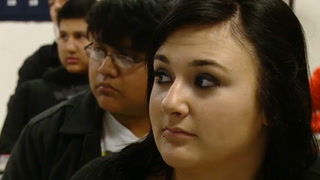
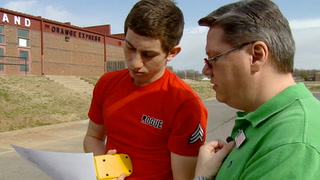
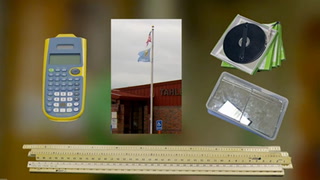
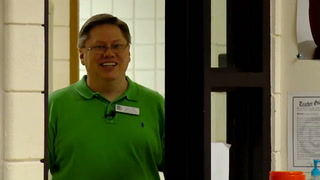
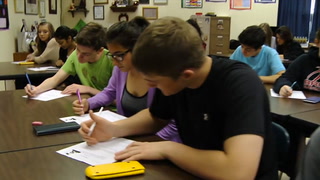









39 Comments
Zina Robinson Jan 24, 2024 9:03pm
Why did the teachers at Tahlequah High School create this course?
The teachers at Tahlequah High School created this course because most of the students with special needs were not accustomed to the Algebra l curriculum.
How does Mr. Akin assess understanding at the beginning of class?
Mr. Akin assesses understanding at the beginning of class by giving the student an activity sheet which allows them to solve the equation step by step. He also gives them a dimenstated answer to help them post their answer in the checker. This allows him to be able to monitor their performance individually and as a whole group.
What strategies do Mr. Akin and Ms. Dowling use to provide extra support to their students?
The strategies that Mr. Akin and Ms. Dowling used to provide extra support to their students are extended time to work on their worksheets, multiplication fact sheets to guide them, multiple ways to retrieve the answers, and guided rules in order to add negative and positive numbers.
Tessa Beach Dec 26, 2023 7:10pm
Struggling students were so far behind, THS started a 2 year program to increase performance in Algebra and state testing.
Creating a numbered list for students to follow for each equation is very helpful. Assessing the understanding of each type of problem helps teachers to decide on lesson for the next day. Having to review from 4 years ago for gaps in understanding is the reason for the class. Giving them lots of space to work out the problems is very beneficial.
Bridgette Williams Nov 28, 2023 2:24pm
Avinus Calloway Oct 9, 2023 2:52pm
1. The teachers at Tahlequah High created this course because these students in this class lacked the foundation skills such as remembering rules for order of operations, basic multiplication and division skills that will be so important in being successful in the advanced class of Algebra.
2. Mr. Akins assess the uderstanding at the beginning of the course by dividing the lesson into small steps to see exactly how much and where the majority of the class will need the most focus.
3. Some strategies that Mr. Akin uses is to instead of focusing on the entire problem in one setting, he have the students to complete the problem in steps of three's, then he looks at the problem steps to see what percentage of the class is struggling with what step. He also uses clickers in his class as device to quickly get feedback on exactly the part of the problem the majority of the class is struggling with.
Michael Daigre Oct 1, 2023 9:12pm
1. Teachers at Tahlequah High School created this course to help students with different learning challenges to better perform in Algebra.
2. Mr. Akin assess understanding at the beginning of class by having his students answer several problem dealing with distributive and like term type problems.
3. Mr. Akin and Ms. Dowling used several strategies to provide extra support to their students, such as positive feedback and a refresher of math fundamentals within a small group setting. Being consistant with positive mental reps and the same instructor for a period of time helps.